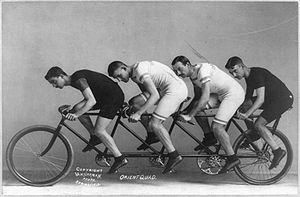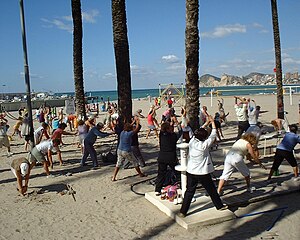After years of struggling with exercise since becoming a ChronicBabe, suddenly everything clicked when I recently read a statement on a fellow POTSie's blog that said (and I'm paraphrasing here) "When you have dysautonomia, all your exercise should be done in the seated position."
What a Well, no duh, why didn't I think of that? moment! After all, I learned last year at the Mayo Clinic in AZ that when I am standing still, my blood pressure goes all over the place, bouncing from high to low and back again. I can only imagine what happens when I try adding movement to standing...
Since this discovery, I've decided to make incorporating seated exercise into my weekly routine one of my goals for 2012. So I went to YouTube looking for some simple seated exercise videos that could get me started. What I found is a variety of videos that range from easy and beginner to experienced and challenging.
My Top Four Picks
My doctor advised me to start with just a few minutes of exercise three times a week and slowly work up to more. So I'm starting with this fun and energetic seated dance video set to Hawaiian music which utilizes a technique called the MUVE method:
I've heard that Zumba is the latest fitness craze and I have been feeling a little left out since an hour dance exercise class is so not practical for me. So imagine my delight when I found this Zumba Gold chair routine that I can do from the comfort of my home.
I'm loving Coach Nicole from SparkPeople.com and her calorie burning Seated Cardio Workout. This is definitely a more advanced workout that I am aspiring to when my fitness level improves. She's also recorded a Seated Upper Body Toning Workout and a Seated Abs Workout too.
Jackie Tally, another new favorite, has several different seated exercise videos on her Smart Moves YouTube channel. My absolute favorite is a routine she set to the song Chicken Fat, a song I remember fondly from my childhood (I am not able to embed it here, so you'll have to head to YouTube to see it.) It seems like a fun way to start the day with exercise!
Honorable Mentions
Mike volunteers with patients living with multiple sclerosis (MS), teaching a seated exercise class in a local hospital. Skip the first minute or so of these videos to get right to the easy five minute seated exercise routines that he teaches to his clients. Then check out the last link for more information about his Move with Mike class.
Seated Exercise Program 1
Seated Exercise Program 2
Move with Mike - Seated MS Exercise Program
I love yoga. Unfortunately, my body with fibromyalgia and chronic myofascial pain doesn't find traditional yoga very relaxing or helpful anymore. That is, until I discovered two seated yoga videos that just work better for me in my current state of health.
Chair Yoga
Chair Yoga Refresher
A Tip for Watching These Videos Anytime
Love these videos, but wish you didn't have to go to YouTube to watch them? Guess what? I discovered that RealPlayer lets you download videos from YouTube to your computer and covert them into several different formats, including MP4, WMV and RealVideo. You can also burn them free of charge to a video CD using the free version of RealPlayer. If you upgrade to RealPlayer Plus, you can burn these videos to DVD.
DISCLAIMER: This post is intended to convey general health information and is not a substitute for professional medical advice. Please consult your health care provider before beginning any exercise program.
















![Reblog this post [with Zemanta]](http://img.zemanta.com/reblog_b.png?x-id=9f2dd752-f66e-4204-b2c7-ffb515e96f1e)
![Reblog this post [with Zemanta]](http://img.zemanta.com/reblog_b.png?x-id=1579c7b6-bb12-48c8-b70d-0ac69db87a96)